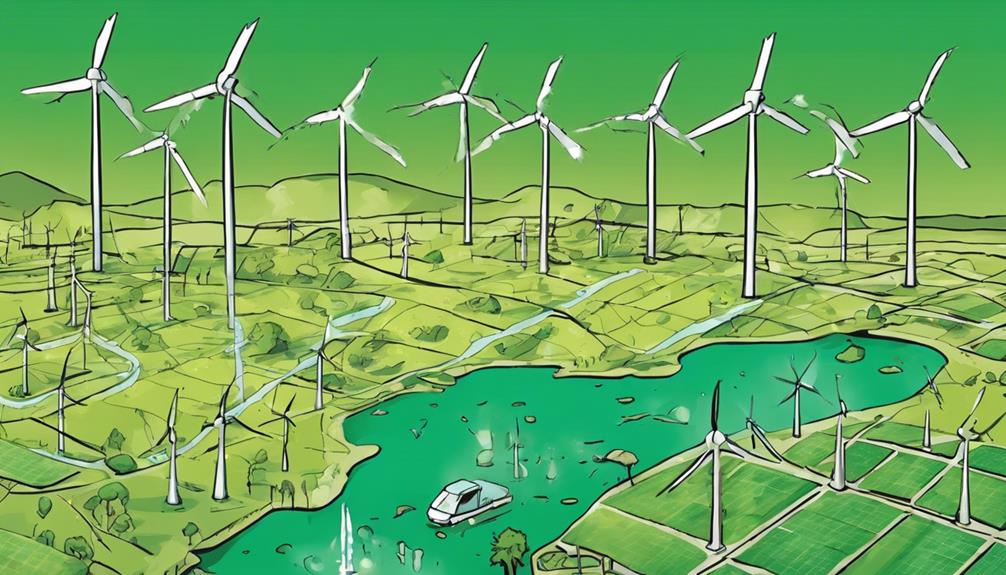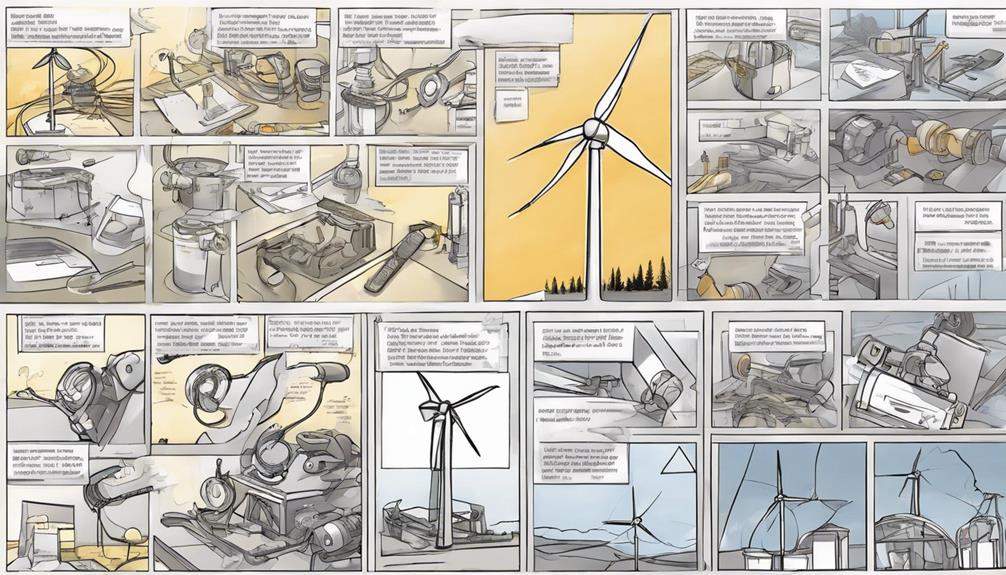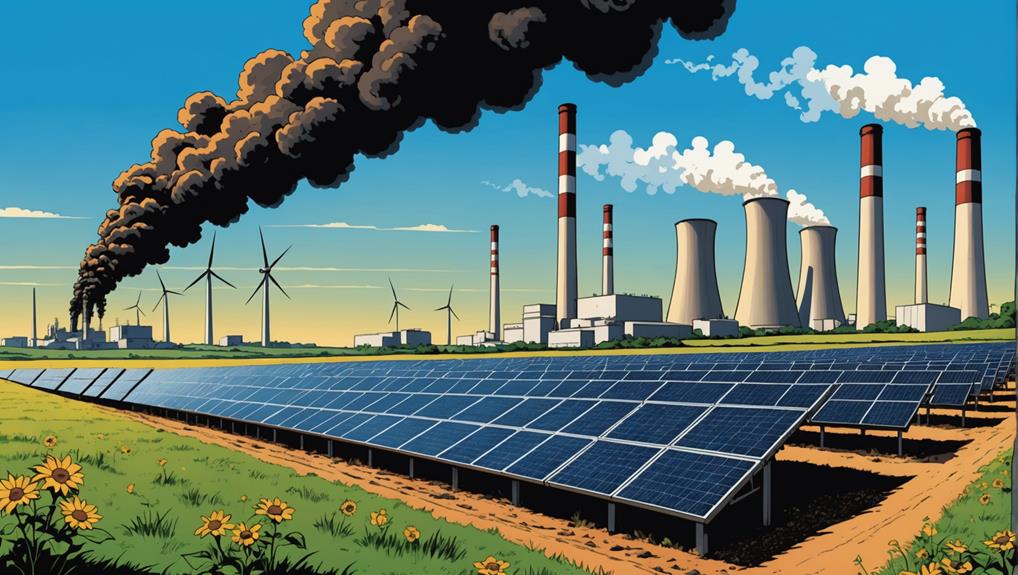You're likely standing on or near the vast geothermal energy reserves that power California, with prominent hotspots like the Salton Sea and the Geysers generating a combined 4,000 megawatts of electricity, enough to light up hundreds of thousands of homes. The production process involves pumping water into underground reservoirs to access the natural heat source, turning it into high-pressure steam, and using it to spin a turbine to generate electricity. As you explore California's geothermal landscape, you'll discover more about the state's potential, benefits, and innovative approaches to accessing this clean energy source – and there's still more to uncover.
Key Takeaways
- California's prominent geothermal resource areas are the Salton Sea and the Geysers, with a combined potential of 4,000 MW of power.
- Geothermal energy production involves pumping water into underground reservoirs, where it's heated, and then used to generate electricity through steam turbines.
- The Salton Sea has a generation capability of 2,200 MW, while The Geysers in Mayacamas Mountains generate 725 MW of electricity.
- There are 43 operational geothermal plants across California, with the potential to double capacity by 2030 and reach 60,000-120,000 MW by 2050.
- Geothermal energy production occurs in various regions, including Imperial Valley, with its unique geological conditions, making it an ideal location for power generation.
Geothermal Energy in California
As you explore the Golden State's energy landscape, you'll find that geothermal energy in California has been an important contributor to the state's electricity mix, accounting for 4.5% of the total in 2018. This renewable energy source has been an essential part of California's energy portfolio, helping to reduce the state's reliance on fossil fuels.
With nearly 15,000 megawatts of geothermal potential, regulators are considering doubling geothermal capacity by 2030. In fact, the U.S. Geological Survey estimates that geothermal capacity in California could reach 60,000-120,000 megawatts by 2050. This growth is largely driven by policies aimed at decarbonization, with companies like Ormat Technologies investing in geothermal projects to reduce carbon emissions.
As California aims to achieve 100% climate-friendly electricity by 2045, geothermal energy will play a pivotal role in achieving this goal. With three local energy providers already signing contracts for new geothermal power plants, California's geothermal market is poised for significant growth, solidifying its position as a leader in clean energy production.
Benefits of Geothermal Power

You'll find that geothermal power offers a unique combination of advantages, making it an attractive option for California's renewable energy mix.
As a reliable and consistent source of renewable energy, geothermal power provides stable, baseline power 24/7. Unlike other forms of renewable energy, geothermal energy has minimal wildlife siting concerns and is less disruptive to habitats. This is why organizations like Audubon California support responsible geothermal energy development aligned with conservation goals.
Additionally, geothermal power plants have a small land footprint, providing ecological and economical benefits compared to other renewable sources. Geothermal energy also creates continuous job opportunities and can be paired with mineral extraction for materials like lithium.
With the Imperial Valley alone having 1500-2000 MW of untapped geothermal capacity, it's clear that geothermal power has the potential to greatly contribute to California's renewable energy goals. By harnessing the earth's heat, geothermal energy can play a crucial role in California's shift to a cleaner, more sustainable energy future.
Geothermal Reservoirs and Leases

As you explore California's geothermal energy production, you'll discover that the state's most significant resource areas are essential to its success.
You'll want to take a closer look at the Salton Sea leases, which are an important part of the state's geothermal landscape.
Geothermal Resource Areas
California boasts two prominent geothermal resource areas, the Salton Sea and the Geysers, which are respectively capable of generating 2,200 MW and 1,800 MW of power. As you explore these areas, you'll find that they're rich in geothermal resources, making them ideal for energy production.
Here's a breakdown of these geothermal resource areas:
| Geothermal Resource Area | Estimated Generation Capacity (MW) |
|---|---|
| Salton Sea | 2,200 |
| The Geysers | 1,800 |
Lease Duration
10 years
Revenue Distribution
50% to state, 25% to county, 25% to U.S. Treasury
The Bureau of Land Management (BLM) manages public lands in California, including the Salton Sea area, for sustainable energy development. Geothermal development in California involves partnerships with various entities, including the California Division of Oil Gas and Geothermal Resources, Imperial Irrigation District, Tribal governments, and private industry.
You'll find that these partnerships are essential in ensuring responsible and efficient geothermal energy production.
Salton Sea Leases
You're now exploring one of California's most significant geothermal energy-producing regions – the Salton Sea area. The Salton Sea area's vast geothermal reservoirs are divided into leases, which have an estimated generation capability of 2,200 MW, making them a significant contributor to California's geothermal energy production. These leases are managed by the Bureau of Land Management (BLM) to ensure sustainable energy development.
When you obtain a lease for geothermal development in the Salton Sea region, it's valid for a 10-year period. The revenue generated from these leases is distributed accordingly: 50% goes to the state, 25% to the county, and 25% to the U.S. Department of the Treasury. This revenue sharing model guarantees that the benefits of geothermal energy production are shared among stakeholders.
As you explore the Salton Sea area, you'll discover that it's home to one of the largest geothermal reservoirs in the U.S. The region's vast geothermal potential makes it an attractive location for energy companies looking to tap into this clean and renewable energy source.
Geothermal Energy Production Process

Heat from the earth's core is harnessed to produce geothermal energy, a process that begins when water is pumped into underground reservoirs to tap into this natural heat source. You'll find geothermal power plants strategically located near these reservoirs, like the Salton Sea in California. Here's how it works:
| Step | Process | Result |
|---|---|---|
| 1 | Water is pumped into underground reservoirs | Access to natural heat source |
| 2 | Heat from the earth's core turns water into steam | High-pressure steam generated |
| 3 | Steam spins a turbine to generate electricity | Electricity produced |
| 4 | Water is cooled for re-use | Conserved water for continuous process |
| 5 | Electricity is transmitted to the power grid | Power distributed to homes and businesses |
In these geothermal power plants, the steam generated from the earth's heat spins a turbine, producing electricity. After electricity generation, the water is cooled for re-use in the process, making it an efficient and sustainable way to produce energy. With the potential to replace traditional baseline power sources like natural gas and coal, geothermal energy is an attractive alternative.
California's Geothermal Potential

As you explore California's geothermal potential, you'll discover that the state has a significant capacity for geothermal energy production.
You'll learn about the existing geothermal resource areas and the vast untapped reserves that remain to be harnessed.
California Geothermal Capacity
With nearly 15,000 megawatts of geothermal potential, California stands out as a leader in geothermal energy production, making it an essential player in the country's clean energy landscape. You might be wondering what this means for the state's geothermal capacity. Well, California already has an existing infrastructure to support geothermal energy development, with 43 geothermal plants listed across the state.
| Category | Current Status | Future Goals |
|---|---|---|
| Geothermal Plants | 43 operational plants | Doubling capacity by 2030 |
| Geothermal Capacity | 15,000 megawatts | 60,000-120,000 megawatts by 2050 |
| Commitment to Clean Energy | Aligns with climate change policies | Achieving carbon neutrality |
Regulators in California are committed to expanding geothermal energy production, with plans to double geothermal capacity on the main power grid by 2030. The U.S. Geological Survey estimates that geothermal capacity in California could grow to 60,000-120,000 megawatts by 2050, highlighting the significant growth potential for geothermal energy in the state. As you can see, California is taking geothermal energy production seriously, and it's clear that geothermal capacity will play an important role in the state's clean energy shift.
Geothermal Resource Areas
You're likely wondering where California's geothermal potential is concentrated, and the answer lies in areas like the Salton Sea and the Geysers, which are known geothermal resource areas. These regions have been identified as hotspots for geothermal energy production, with the Salton Sea resource area boasting an estimated geothermal generation capability of 2,200 MW.
Here are some key facts about California's geothermal resource areas:
- The Salton Sea: With a generation capability of 2,200 MW, it's a significant geothermal reservoir.
- The Geysers: Located in the Mayacamas Mountains, it's the largest complex of geothermal power plants globally, generating 725 MW of electricity.
- Existing Infrastructure: California Energy Commission lists 43 geothermal plants in the state, highlighting the existing infrastructure for geothermal energy production.
- Future Expansion: Regulators in California are considering doubling the geothermal capacity on the state's main power grid by 2030 to further tap into the state's geothermal potential.
These resource areas are essential for California's geothermal energy production, and their potential is being harnessed to meet the state's growing energy demands.
Untapped Geothermal Reserves
California boasts an enormous untapped geothermal potential, with estimates suggesting that the state holds nearly 15,000 megawatts of geothermal capacity waiting to be harnessed.
You might be surprised to know that the Imperial Valley alone has 1500-2000 MW of untapped geothermal capacity, making it a significant hotspot for future development. Regulators in California are taking notice, considering plans to double the state's geothermal capacity on the main power grid by 2030.
But that's not all – the U.S. Geological Survey estimates that geothermal capacity in California could potentially grow to 60,000-120,000 megawatts by 2050, highlighting the vast untapped resources. With 43 geothermal plants already operating in California, the state has the infrastructure and potential for significant expansion in geothermal energy production.
As you explore the possibilities of geothermal energy in California, it's clear that the state is poised to become a leader in this renewable energy source.
Geothermal Power Plant Development

Developers are actively constructing new geothermal power plants in California, particularly near the Salton Sea and Mono County, to harness the state's vast geothermal resources. As you explore the state's geothermal landscape, you'll notice a surge in construction activity. This is because California aims to double its geothermal capacity on the main power grid by 2030, with plans to reach 100% eco-friendly electricity by 2045.
Here are some key facts about geothermal power plant development in California:
- 43 geothermal plants are already operational in the state.
- The U.S. Geological Survey estimates California's geothermal capacity could grow to 60,000-120,000 megawatts by 2050.
- New initiatives are being developed in Imperial and Mono Counties to achieve full decarbonization.
- Companies such as Ormat Technologies are investing in geothermal projects to reduce carbon emissions.
As you explore further into California's geothermal industry, you'll see how geothermal plants are playing a significant role in the state's shift to clean energy.
Audubon California's Support

As you explore Audubon California's stance on geothermal energy, you'll find that their conservation goals align perfectly with this renewable energy source.
You'll discover that geothermal power plants have a minimal impact on wildlife habitats, which is a top priority for Audubon California.
Audubon's Conservation Goals
You can count on Audubon California to promote responsible renewable energy development that aligns with their conservation goals, and geothermal energy production fits the bill. As a champion of environmental stewardship, Audubon California supports renewable energy sources that minimize habitat disruption and wildlife impacts. Geothermal power, with its low habitat disruption and minimal wildlife siting concerns, is a preferred choice for the organization.
Here are 4 key reasons why geothermal energy aligns with Audubon's conservation goals:
- Minimal habitat disruption: Geothermal power plants have a relatively small footprint, reducing the risk of habitat destruction and fragmentation.
- Low wildlife siting concerns: Geothermal energy production has a lower impact on wildlife compared to other renewable energy sources.
- Responsible development: Audubon California advocates for responsible geothermal energy development that prioritizes environmental conservation.
- Preferred renewable energy option: Geothermal energy is a preferred choice for Audubon California due to its relatively low environmental impact.
Geothermal's Low Impact
Audubon California's backing for geothermal energy stems from its impressive low-impact profile, which aligns perfectly with the organization's conservation goals. As you delve into the benefits of geothermal energy, you'll find that it has a minimal impact on wildlife habitats. Unlike other forms of energy production, geothermal power plants don't disrupt natural habitats, and wildlife siting concerns are virtually non-existent.
This low-impact approach ensures that the environment remains protected while still providing a reliable source of energy.
You'll appreciate the stable, baseline power that geothermal energy offers, which is essential for meeting California's energy demands. In addition, geothermal plants create continuous job opportunities and can even be paired with mineral extraction for materials like lithium.
Responsible Energy Development
California's transition to a sustainable energy future relies on responsible development. Audubon California advocates for geothermal energy production that prioritizes minimal wildlife impact and habitat disruption. As you consider the benefits of geothermal energy, grasping the importance of responsible energy development is crucial.
Here are four key reasons why Audubon California supports geothermal energy:
- Minimal habitat disturbance: Geothermal power plants have a small footprint, reducing the risk of habitat destruction and fragmentation.
- Fewer wildlife placement concerns: In comparison to other renewable energy sources, geothermal power plants have fewer wildlife placement concerns, making them a more environmentally friendly choice.
- Consistency with conservation objectives: Geothermal energy is in line with Audubon's conservation objectives for sustainable energy, ensuring a healthier planet for future generations.
- Appropriate site selection and wildlife conservation: Audubon California advocates for appropriate site selection and wildlife conservation in renewable energy projects, ensuring that geothermal energy production is both sustainable and responsible.
Geothermal Energy Innovations

As the geothermal industry continues to evolve, cutting-edge innovations are transforming the way heat from the earth's core is harnessed, paving the way for more efficient and sustainable energy production. You're probably wondering what these innovations entail. Let's delve into!
| Innovation | Description | Benefits |
|---|---|---|
| Advanced Drilling Tech | Enables deeper and more efficient extraction of heat | Increased energy production, reduced costs |
| Geothermal Energy Storage | Addresses intermittent power generation, enhances grid stability | Reliable and consistent energy supply |
| Hybrid Geothermal Systems | Combines geothermal energy with other renewables | Increased efficiency, reduced emissions |
| Geothermal Heat Pumps | Utilizes earth's constant temperature for heating and cooling | Energy-efficient, cost-effective |
| Ongoing R&D | Improves efficiency, reduces costs, expands utilization | Enhances sustainability, competitiveness |
One notable example is the Diablo IV Geothermal project, which leverages advanced drilling technologies to tap into deeper, hotter reservoirs, increasing energy production while reducing costs. These innovations are revolutionizing the geothermal industry, making it a more viable and attractive option for you and the environment.
Market Trends and Pricing

You're likely wondering what kind of market trends and pricing are driving the geothermal industry forward in California, and the answer is a competitive landscape that's making geothermal power a more attractive option. As you explore the market, you'll find that geothermal power costs are competitive with other renewable sources, making it an appealing choice for companies and consumers alike.
Here are some key market trends and pricing highlights:
- Competitive pricing: Contracts signed by entities like Monterey Bay Community Power and Silicon Valley Clean Energy demonstrate geothermal power's competitive edge.
- Resurgence in California: New geothermal projects, like the Hells Kitchen plant, offer geothermal power at 7.4 cents per kilowatt-hour, driving growth and expansion.
- Investment and optimism: Companies like Ormat Technologies are investing in geothermal projects, viewing geothermal as a key resource for achieving full decarbonization and reducing carbon emissions.
- Bright future: Geothermal advocates and entrepreneurs are optimistic about the future market for geothermal energy in California, driven by the state's climate change policies and goals for clean energy.
These market trends and pricing developments are fueling the geothermal industry's growth in California, making it an exciting time for this clean energy source.
Geothermal Energy Production Sites

You're likely familiar with The Geysers, a sprawling geothermal complex in California's Mayacamas Mountains, which generates 725 megawatts of electricity from 13 power plants operated by Calpine, making it the largest geothermal power plant operation globally. This complex provides power to 725,000 homes and meets the energy needs of multiple counties in California. In 2018, it contributed 50% of California's geothermal generation and accounted for 9% of the state's green power.
The Geysers showcases the benefits of tapping into the earth's natural heat for electricity production, offering a reliable and high availability energy source. You'll find similar geothermal energy production sites in Imperial Valley, where the Salton Sea Geothermal Field is located. These unique sites have the earth's heat close to the surface, fractured rock layers for water percolation, and specific geological conditions required for converting heat into power.
Frequently Asked Questions
Where and How Is Geothermal Energy Produced?
You're wondering where and how geothermal energy is produced? It's generated by harnessing steam from the earth's heat to spin turbines, producing electricity; you'll find it in areas with significant geological activity, like volcanic regions or hot springs.
Why Does California Produce so Much Geothermal Energy?
You're standing on California's hotbed of geothermal energy, where the state's natural heat is harnessed to power homes. You produce so much geothermal energy because of your abundant resources, commitment to renewables, and ambitious clean energy goals.
Can You Do Geothermal in California?
You can definitely do geothermal in California, and it's a great idea! With abundant resources and a supportive regulatory environment, you'll find numerous opportunities to harness this clean energy source, from residential installations to large-scale power plants.
Why Is California the Best State for Geothermal Energy?
You're wondering why California is the best state for geothermal energy? It's because you're sitting on a goldmine of geothermal potential, with an ideal location and abundant resources, making it the perfect spot for harnessing this clean energy!
Can Geothermal Energy Replace Hydrogen as a Sustainable Fuel Source in California?
Geothermal energy holds great potential in California, but “why hydrogen fuel not” is still a viable option. Geothermal power can provide a steady source of clean energy, but hydrogen fuel offers flexibility in transportation. Both have their strengths, and a balanced approach might be the best solution for a sustainable future.
Conclusion
As you explore California's geothermal landscape, remember that this clean energy source isn't just a possibility, but a reality.
You've seen the benefits, the potential, and the innovative spirit driving it forward.
Now, you can join the movement, supporting policies that foster growth, investing in research that pushes boundaries, and advocating for a future where geothermal energy powers California's homes, schools, and businesses, illuminating a brighter tomorrow for all.










